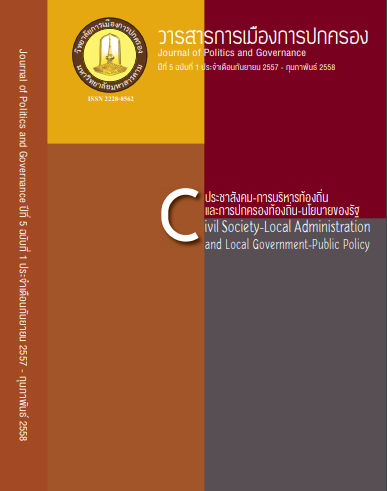Understanding Public Sphere and Attitudes towards Public Services: Perceptions from Selected Rural Philippine and Thai Residents
Main Article Content
Abstract
This is an exploratory study that aims to contribute to the understanding of the public sphere in the context of democracy and active citizenship and to apply the concept in public administration and governance. The New Public Sphere model serves as theoretical guide for the community-centeredness ideal of public agencies and the concomitant significance of active citizenship. Habermas’s theory of communicative action also serves to buttress the study’s theoretical underpinning within the deliberative democracy continuum. The study points the enhancement of public services as its development goal, thereby exploring how the complex concept of public sphere and its novel application in public administration field may be examined further. Public sphere in this study is therefore initially regarded as a means to an end (i.e. how knowledge on the sphere may be used for the improvement of public services) and the psychological conditions on the part of the rural respondents in which it thrives are made to surface. The results and analysis are mostly descriptive, extracting from perceptions of respondents from rural geographical and political adjacent locations in Thailand and the Philippines.
Article Details

This work is licensed under a Creative Commons Attribution-NonCommercial-NoDerivatives 4.0 International License.
References
Barbalet, J.M. (1988).Citizenship: Rights, struggle, and class inequality. University Avenue Southeast, Minneapolis: University of Minnesota Press.
Brans, M. (2007).Comparative public administration: From general theory to general frameworks. In Guy Peters B. & J. Pierre. (Eds.).The handbook of public administration. London: Sage Publications.
Castells, Manuel. (2008). The new public sphere: Global civil society, communication networks, and global governance. The Annals of the American Academy of Political and Social Science (AAPSS), 616(March), 78. Accessed at: http://ann.sagepub.com/content/616/1/78 on July 2013.
Co, Edna E.A., Fernan, Ramon III, Diola, Maria Faina, Rasul, Amina, et al. (2013). State of local democracy in the autonomous region in Muslim Mindanao (ARMM). Quezon City: University of the Philippines -National College of Public Administration (UP-NCPAG), Philippine Council for Islamic Democracy (PCID), and International Institute for Democracy and Electoral Assistance (International IDEA)
Denhardt, Janet V. and Robert B. Denhardt. (2007). The new public service. New York: M.E. Sharpe.
Diola, M.F.L. (2009). Social capital formation in selected conflict areas and local governance in Mindanao. Philippine Journal of Public Administration (PJPA), 53 (1-2,), 47-85. Quezon City: University of the Philippines-National College of Public Administration and Governance.
Edwards, Michael. (2004). Civil society. Cambridge, Oxford, U.K. and Malden, U.S.A.: Polity Press and Blackwell Publishing.
Frederickson, H. George. (1991). Toward a theory of the public for public administration. Administration and Society, 22(4), 395-417.
Gill, Graeme. (2000). The dynamics of democratization: Elites, civil society and the transition process. Hampshire and London: Macmillan Press.
Habermas, Jurgen. (1984).The theory of communicative action. Reason and the rationalization of society (vol. one).Boston : Beacon Press).Retrieved December 2013, from:
http://blogs.unpad.ac.id/teddykw/files/2012/07/Jurgen-Habermas-Theory-of-Communicative-Action-Volume-1.pdf
Gueye, Semou Pathe. (2005). Public sphere and deliberative democracy: Rethinking politics. In Antonio F. Perez, Semou Pathe Gueye and Fenggag Yang. Eds. Civil society as democratic practice. Washington, D.C., U.S.A.: Council for Research in Values and Philosophy.
Huntington,Samuel P. (1991). Democracy’s Third Wave. Journal of Democracy. 2, 2 (Spring). Accessed: http://www.ou.edu/uschina/gries/articles/IntPol/Huntington.91.Demo.3rd.pdf on October 2013.
Kocan, Gurcan. (2008). Models of public sphere in political philosophy. Eurosphere Working Paper Series. Online Working Paper No. 02, 2008. Accessed at: http//eurosphere.uib.no/knowledgebase/workingpapers.htm. January 2014.
National Democratic Institute (NDI). (2010). Democracy survey shows opportunities, ongoing challenges for political participation in El Salvador. Accessed: https://www.ndi.org/node/16020. July 2013
Perry, James. (2006). Democracy and the new public service. Revised version of the Monroe-Paine Lecture delivered at the University of Missouri-Columbia, November 11, 2005 and the Dan and Carole Burack President’s Distinguished Lecture delivered at the University of Vermont, April 3, 2006.
Peters, B. Guy and Pierre, J. (2007).The handbook of public administration. London: Sage Publications.
Pierre, J. (Ed.). (1995). Bureaucracy in the modern state. An introduction to comparative public administration. Aldershot: Edward Elgar.
Roderick, Rick (1986). Habermas and the Foundations of Critical Theory. New York: St. Martin's Press,


